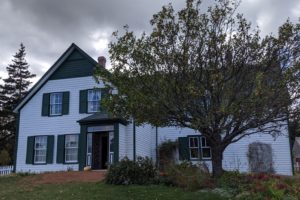On our last full day in Cape Breton, we drove into Sydney to have a look at the waterfront. With the plan of finding a parking space and walking over to the wharf, we instead found a house that was built in 1786 and was one that I had wanted to visit.

This house is one of the oldest remaining wooden buildings in Colonial Sydney. The building’s history shows the change from a strictly commercial building to commercial/residential to purely residential.
Sydney as the capital
Sydney was the capital of the Colony of Cape Breton from 1785 until it was annexed to mainland Nova Scotia in 1820. After this union, property values declined, but Sydney experienced moderate growth throughout the better part of the 19th century. Incorporated in 1904, the new City of Sydney grew up around the older Colonial Town. This North End has houses from the early and mid-1900s alongside buildings dating from colonial days.
back to the Jost House
Samuel Sparrow, merchant and ship owner, owned the property from 1786 to 1787. The basement has been restored to his original 18th century kitchen with a cooking fireplace, a separate beehive bake-oven, and an overhead ceiling plastered between the supporting beams.
Here’s the basement kitchen:

Lorie, the woman sitting in the chair said up to 12 dozen loaves of bread could be baked a day in the bread oven to be sold in the store upstairs.
(Side note: Lorie used to work at the KOA where we’re staying, and her husband still works there during the summer taking care of the grounds. They live full-time on the campgrounds in a trailer next to the hosts and are good friends with them. Whenever a camper has a question about Sydney the can’t answer, Lorie is the go-to person.)
All of the beams, bricks, and stonework are original. Only half of the basement is really furnished for living/working.


This metal rod came out of the fireplace so pots could be hung from it and moved into the fire.

She told us that women in the 1700s thought that wide hips were fashionable so they wore hip extenders under their clothes. On an Outlander season 1 episode, we saw Mrs. Fitz add these hip extenders under Claire’s clothes and, yes, her hips really did look wider!
Fire for the bread oven would have been going 24 hours a day, 7 days a week, even through the hot summers. Since the fires were hard to start, it just made sense to keep the fires burning.


Sure would hate to have to do laundry this way.

Thomas Jost, a Halifax merchant, bought the property in 1836 and his descendants lived here until 1971. Historical Victorian artifacts for the ground floor bedroom, parlor, dining room, and store (until 1853) are still being collected. Here’s a look at the ground floor.

Curtains around the bed provided both warmth and privacy. A dressing screen was used while changing.



a warming closet?




dining room




the parlor


half of the store space

In the early 1900s, the roof was raised and the second floor extended to include bedrooms and bath. Now the museum has some rooms upstairs that we’ll be seeing.

upstairs




When temperance laws came into effect, people began scrambling for legal ways to get alcohol, so doctors began prescribing brandy, rum, and wine. If straight rum wasn’t possible, medicines with alcohol were prescribed.


Victorian room






For thousands of years, salt has been key for food preservation, as a core spice, and as a trade item. It made possible for Atlantic catches caught in North America to reach European markets.

This reproduction of an Edwardian day dress from 1905 is so beautiful.

more christening dresses


wallpaper history

outside
As we were leaving the Jost House, we met Ken, a volunteer tour guide for the cruise ships. He said on a normal week, 3 to 4 ships dock across the street. During September and October, they get 3 to 4 ships a day! Ken also said that Sydney is starting to make a comeback after having a number of rough years. A container company is going to be going it across the wharf to store containers for large ships.


Now it’s time for lunch, and 2 people recommended the Governor’s Pub and Eatery.












